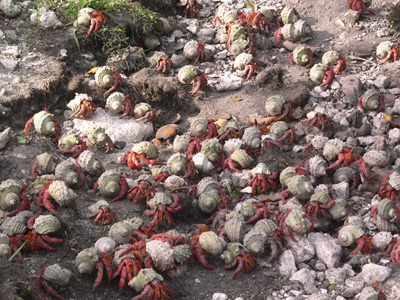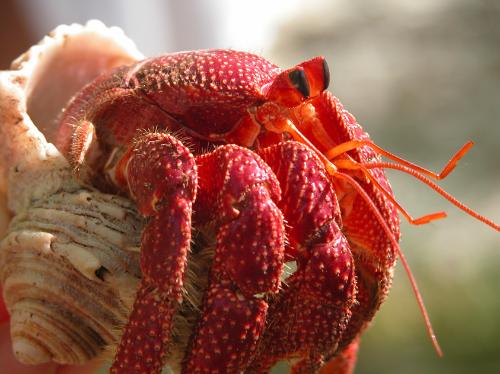Published in the Ocean Watch column, Honolulu Star-Advertiser © Susan Scott
February 25, 2013
My recent column about the successful elimination of rats from Palmyra Atoll, a National Wildlife Refuge 1,000 miles south of Hawaii, garnered some good questions and comments.
A reader, Jean, emailed, “So the rat poison destroys the rats and the curlews had to be removed. But how are the rats disposed of?”
They were recycled. In 24 hours, Palmyra’s amazing land crabs gobbled up every last morsel of rat, including fur and bones. All that was left, I was told, were little piles of teeth.
 Strawberry hermit crabs on Palmyra atoll.
Strawberry hermit crabs on Palmyra atoll.
©2013 Susan Scott
Six kinds of native land crabs roam Palmyra’s 25 islets. Most people know about the colossal coconut crabs weighing up to 10 pounds with 3-foot-wide leg spans. While I worked in Palmyra, however, the far more numerous strawberry hermit crabs, named after their dimpled red bodies the size of jumbo strawberries, stole my heart.
Like all hermit crabs, strawberry hermits live in empty seashells to protect their soft, vulnerable backsides. On Palmyra the shell of choice is a white spiraled snail shell. When wearing those “turbans,” the bright red crabs look like walking strawberries dipped in swirls of white chocolate.

The total number of crabs of all species on Palmyra is hard to estimate because populations are high in some areas, low in others. One rough estimate was about 100,000 individuals. With the rat population at the time of eradication around 30,000, that’s at least three crabs for each rat.
The researchers easily found rat carcasses simply by looking for piles of crabs.
In the same column, my statement that bristle-thighed curlews are the only shorebirds known to use tools prompted reader David to send me a video of a green heron using bread to catch fish (“Clever Bird Goes Fishing” at goo.gl/R9dPj). I had seen this remarkable clip before, but I can’t watch it enough times.
Although this bird is standing on the shore, as most herons do, the tool-using green herons are classified as water birds, a separate category from shorebirds.
Hawaii’s shorebirds, including bristle-thighed curlews, or kioea, are here right now in all their glory. Molokai reader Arleone Dibben-Young emailed that a curlew satellite-tagged on Oahu’s North Shore flew to Molokai for lunch last week.
The kioea, Arleone writes, has recently been named the official bird of Kaunakakai. Fans hope the designation will raise awareness of the species’ special role in Molokai’s culture and natural history, and help protect these rare native treasures.
Thanks, all, for taking the time to write.